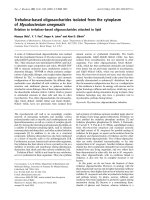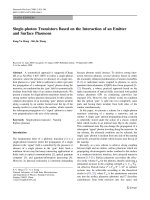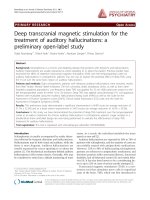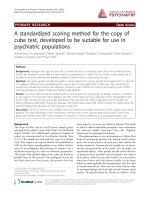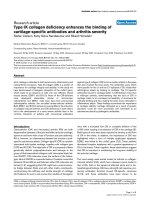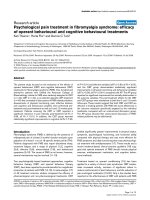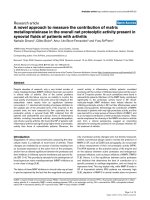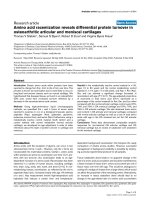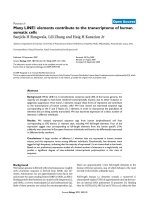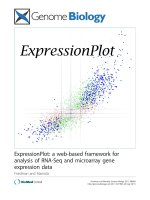Báo cáo y học: "Type IX collagen deficiency enhances the binding of cartilage-specific antibodies and arthritis severity" docx
Bạn đang xem bản rút gọn của tài liệu. Xem và tải ngay bản đầy đủ của tài liệu tại đây (744.94 KB, 8 trang )
Open Access
Available online />Page 1 of 8
(page number not for citation purposes)
Vol 8 No 4
Research article
Type IX collagen deficiency enhances the binding of
cartilage-specific antibodies and arthritis severity
Stefan Carlsen, Kutty Selva Nandakumar and Rikard Holmdahl
Medical Inflammation Research, BMC I11, Lund University, SE-221 84 Lund, Sweden
Corresponding author: Rikard Holmdahl,
Received: 30 Mar 2006 Revisions requested: 10 May 2006 Revisions received: 26 May 2006 Accepted: 6 Jun 2006 Published: 3 Jul 2006
Arthritis Research & Therapy 2006, 8:R102 (doi:10.1186/ar1989)
This article is online at: />© 2006 Carlsen et al.; licensee BioMed Central Ltd.
This is an open access article distributed under the terms of the Creative Commons Attribution License ( />),
which permits unrestricted use, distribution, and reproduction in any medium, provided the original work is properly cited.
Abstract
Joint cartilage is attacked in both autoimmune inflammatory and
osteoarthritic processes. Type IX collagen (CIX) is a protein of
importance for cartilage integrity and stability. In this study we
have backcrossed a transgenic disruption of the col9a1 gene,
which leads to an absence of CIX, into two different inbred
mouse strains, DBA/1 and B10.Q. None of the CIX-deficient
mice developed observable clinical or microscopic
osteoarthritis, but DBA/1 male mice had more pronounced
enthesopathic arthritis, the so-called stress-induced arthritis.
Both DBA/1 and B10.Q strains are susceptible to the induction
of collagen-induced arthritis, and CIX deficiency in both strains
led to the development of a more severe arthritis than in the
controls. Induction of arthritis with monoclonal antibodies
against type II collagen (CII) led to an earlier arthritis in the paws
that also involved the knee joints. The antibodies used, which
were specific for the J1 and the C1
I
epitopes of CII, initiate their
arthritogenic attack by binding to cartilage. The C1
I
-specific
antibodies bound to cartilage better in CIX-deficient mice than
in wild-type animals, demonstrating that the lack of CIX in
cartilage leads to an increased accessibility of structures for
antibody binding and thus making the joints more vulnerable to
inflammatory attack. These findings accentuate the importance
of cartilage stability; cartilage disrupted as a result of genetic
disorders could be more accessible and vulnerable to an
autoimmune attack by pathogenic antibodies.
Introduction
Osteoarthritis (OA) and rheumatoid arthritis (RA) are both
degenerative diseases of the joint and affect articular cartilage,
synovium and bone with a loss of function and joint deformity.
RA is, however, an inflammatory disease that involves a joint-
specific autoimmune attack. Collagen type IX (CIX) is a protein
associated with hyaline cartilage, together with collagen type
II (CII) and XI (CXI). The triple helix of CIX is composed of three
genetically distinct polypeptide-chains and belongs to the
group of fibril-associated collagens with interrupted triple hel-
ices (FACIT). CIX molecules cover the surface of the hetero-
typic fibril of CII/CXI in a periodic fashion. Covalent cross-links
between CII and CIX as well between other CIX molecules are
formed [1-3], suggesting that CIX might form a macromolecu-
lar bridge between fibrils and with other matrix constituents,
compromising the stiffness and tensile strength of cartilage
[4]. Evidence for such a role comes from studies of transgenic
mice with a truncated form [5] or complete deletion of the
α1(IX) chain, leading to an absence of CIX in the cartilage [6].
Both types of mice have been reported to develop a mild form
of OA in the knees. In addition, the importance of CIX was
highlighted when a form of multiple epiphyseal dysplasia,
EDM2, was linked to the col9a2 gene [7,8]. These patients
developed irregular epiphyses with a gradual appearance of
OA in the knees. Taken together, these observations suggest
that CIX is important in maintaining the long-term stability of
the articular cartilage.
The most widely used animal model for arthritis is collagen-
induced arthritis (CIA), which has a disease course similar to
that of RA, both in the spread of affected joints and in his-
topathological findings. CIA has a strong B-cell response, pro-
ducing antibodies directed toward CII-specific structures
[9,10], and these antibodies have been shown to be
CAIA = collagen-antibody-induced arthritis; CII = type II collagen; CIX = type IX collagen; CIA = collagen-induced arthritis; COMP = cartilage oligo-
meric matrix protein; ELISA = enzyme-linked immunosorbent assay; IFN = interferon; OA = osteoarthritis; PBS = phosphate-buffered saline; PCR =
polymerase chain reaction; RA = rheumatoid arthritis; SIA = stress-induced arthritis.
Arthritis Research & Therapy Vol 8 No 4 Carlsen et al.
Page 2 of 8
(page number not for citation purposes)
pathogenic in passive transfer experiments [11-15]. CII-spe-
cific T cells promoted the arthritis initiated by these antibodies
[16-18]. A requirement for T cells in CIA was demonstrated by
using anti-CD4 [19] or anti-TCRαβ [20] monoclonal antibod-
ies and T-cell-deficient mice [21]. However, T cells alone can-
not explain the pathology in CIA; hence both humoral immunity
and cellular immunity were found to be absolutely essential
[17]. Similarly, it is also possible to study arthritogenic path-
ways by using animal models other than CIA to pinpoint the
effect of different disorders and thereby fine-tune the under-
standing of the underlying mechanisms of RA. Such models
are collagen-antibody-induced arthritis (CAIA) and stress-
induced arthritis (SIA).
In CAIA it is possible to study the inflammatory phase of the
immune response without involving the primary phase by acti-
vating a cascade of reactions involving complement [22] and
Fcγ receptors [23]. Neutrophils and macrophages are the
major mediators of this inflammation [12]. CAIA is also capa-
ble of initiating arthritis independently of T and B cells, actually
in the absence of either T or B cells, but not both enhanced
the disease, arguing for a regulative role for these cells [16].
SIA is a spontaneous arthritis occurring in old male DBA/1
mice that are grouped from different litters. Macroscopically, it
is similar to CIA, with edema and deformity of the hindpaws;
however, SIA is primarily an enthesopathy characterized by the
proliferation of fibroblasts and the formation of periarticular
enthesophytes of cartilage and bone that can result in marginal
ankylosis. In contrast to CIA, SIA is T-cell independent and
shows minimal proliferative synovitis, without involving large
cellular infiltrates [24].
Ankylosing enthesitis is a pathological feature in a group of
chronic arthritides known as spondylarthropathies, with the
same inflammatory mediators as in RA. IFN-γ (secreted proba-
bly by the innate immune system involving IFN-γ producing
cells such as natural killer and myeloid cells) was shown to
promote SIA [25]. It has been well documented that bone mor-
phogenetic protein (BMP), a member of the transforming
growth factor (TGF) superfamily, is involved in endochondral
bone formation. Recently, an antagonist to BMP was shown to
inhibit the onset and progression of SIA [26]; however, TGF-
β1 injected directly into the knees induced enthesopathies
[27]. The causative factor of spondylarthropathies is believed
to be an endocrine disorder in humans [28] and might also be
a compensatory mechanism of joint instability, supported by
the stabilization process of osteoarthritic knees [29].
This study was designed to address whether the development
of autoimmune arthritis as in RA might be dependent on carti-
lage quality. To address this question we used CIX mutant
mice lacking the α1 (IX) chain [6] and assumed that this
mouse might be more susceptible to inflammatory arthritis
because of mild cartilage matrix destabilization. The data pre-
sented here confirmed our hypothesis that these mice devel-
oped a more severe arthritis in CIA and CAIA, which could be
explained by an enhanced accessibility of CII-specific antibod-
ies to cartilage. We also found that this mouse was more
prone to developing enthesopathy but we could not reproduce
earlier findings that the CIX deficiency leads to OA.
Materials and methods
Animals
The transgenic mice harboring mutant col9a1 have been
described previously [6]; in brief, exon 8 of col9a1 was dis-
rupted by inserting a phosphoglycerate kinase 1 (pgk-1) pro-
moter-neomycin gene cassette. Homozygous mutant mice
lacked both mRNA and polypeptide, but even though col9a2
and col9a3 transcription was normal the polypeptides were
not detectable in cartilage. The CIX-deficient mice, denoted
C9T, were then backcrossed to B10.Q/Rhd (originally from
Jan Klein, Tübingen, Germany) and DBA/1/Rhd (originally
from Jackson laboratories Inc., Bar Harbor, ME, USA) animals.
Rhd indicates that these classical inbred mouse strains have
been maintained in our laboratory for more than two decades.
The two lines were further denoted by the suffixes -BQ and -
DQ, to indicate B10.Q and DBA/1 backgrounds, respectively.
The mice were backcrossed for 10 or 11 generations and the
remaining fragment was analyzed with microsatellite markers
between positions 6.5 and 43.1 centimorgans on chromo-
some 1 (see Figure 1 below). SinceC9T-BQ was determined
as being free from genetic contamination, this line was kept by
intercrossed breeding, and B10.Q animals were used as con-
trols in the experiments.
All mice were kept in a climate-controlled environment with 12
hours light/12 hours dark cycles, housed in polystyrene cages
containing wood shavings, standard rodent chow and water
ad libitum in the Animal Department of Medical Inflammation
Research in Lund, Sweden. All experiments were performed
on age-matched mice, between 8 and 16 weeks of age. The
Lund-Malmö laboratory animal ethical committee approved the
animal experiments described in this article.
Screening
Genomic DNA was prepared from the tip of tail or toe [30].
Transgenic mice were screened by PCR with primer pairs spe-
cific for the NeoR gene within the construct. Wild-type animals
were determined by using another primer pair inside the
Col9a1 gene that flanked the construct, yielding an incom-
plete product without amplification if the construct was
present. Both primer pairs were run simultaneously for each
sample during PCR, to yield on agarose gel electrophoresis
two different products from each pair, depending on the
haplotype.
Available online />Page 3 of 8
(page number not for citation purposes)
Induction and evaluation of arthritis
CIA
Mice were immunized intradermally at the base of the tail with
50 or 100 µg of CII, prepared from Swarm rat chondrosar-
coma. All dosages were emulsified with complete Freund's
adjuvant (Difco, Detroit, IL, USA) in a total volume of 100 µl. In
early experiments, arthritis was followed by using the original,
referred to as the simple, macroscopic score system for the
four paws ranging from 1 to 3: 1 = swelling or redness in one
joint or toe; 2 = more than one joint/toe or the ankle affected;
3 = severe arthritis in the entire paw. During later experiments
the scoring protocol was improved and animals were scored
by the system ranging from 0 to 15 per paw [31], referred to
as the extended protocol. For comparison, scores used with
the extended system have been converted from original docu-
ments for each individual and day in accordance with the fol-
lowing relation between extended and simple: 1 = 1, 2 to 10
= 2, and 11 to 15 = 3.
SIA
Spontaneous development of arthritis is influenced by hormo-
nal and behavioral factors [32]. It has been stressed that the
number of mice is critical (at least three), and grouping should
be from sexually mature mice from different litters for the induc-
tion of SIA. Selection was used randomly to reduce cage var-
iations. Arthritis was assessed as described above.
CAIA
To induce arthritis with anti-CII antibodies, GammaBind™ Plus
Sepharose™ column (Amersham Biosciences, Uppsala, Swe-
den) purified IgG from the culture supernatants of B-cell hybri-
domas CIIC1 (C1
I
epitope) and M2139 (J1 epitope) [33-35]
were solubilized in PBS, sterile filtered and injected intrave-
nously [12]. Each antibody (4.5 mg) was given as a cocktail on
two occasions in a total volume of 400 µl. On day 5, 50 µg of
lipopolysaccharide per mouse was injected intraperitoneally
into all mice. Arthritis was assessed as described above.
ELISA
ELISA was performed with sera obtained at day 35 from mice
through retro-orbital plexus bleeding. Microtiter plates (Immu-
nolon 2 HB; Thermo Labsystems, Franklin, MA, USA) were
used, otherwise the protocol was followed as described else-
where [36].
Histology
CIIC1 (C1
I
epitope, ARGLT), M2139 (J1 epitope, MPGER-
GAAGIAGPK), CIIC2 (D3 epitope, ARGAQGPPGATGFP),
CIIF4 (F4 epitope, ERGLKGHRGFT) and CIIE8 (E8 epitope,
LAGQRGIV) antibodies were biotinylated as described previ-
ously [33]; 100 µg of antibodies in 100 µl of PBS was then
injected intraperitoneally into 1-day-old mice [37]. The mice
were decapitated a day later and the hindlimbs were immedi-
ately embedded in OCT compound (Sakura Finetek, Zoeter-
woude, The Netherlands), snap-frozen in isopentane and kept
frozen at -70°C until cryosectioning. Staining was performed
as described previously [38].
Calculation of antibody binding
Sections were selected from the ankle region with homoge-
nous, whole, round parts and from the same joint part as pos-
sible. All pictures were taken on the same occasion and stored
as high-grade TIFF files, with SPOT advanced WIN v. 4.1 soft-
ware (Digital Instruments Inc., Sterling Heights, MI, USA). All
image analyses were performed at the same time with Easy
Image Analysis 2000 v. 2.7.1.3 (Tekno Optik AB, Huddinge,
Sweden) with threshold levels set as specifically as feasible
and used unchanged throughout the analysis. The total area
was marked manually and the software marked the stained
area. The software calculated the stained area as a percent-
age of the total.
Statistics
All ELISA data were first log-transformed and then used for
calculations of the mean and an independent-samples t test,
except for SD. Mean ELISA values are expressed as the anti-
Figure 1
Genetic map of chromosome 1 around the col9a1 geneGenetic map of chromosome 1 around the col9a1 gene. Shown is a
map of the genotyped chromosome 1 from 10th and 11th generations
of mice backcrossed to B10.Q (C9T-BQ) and DBA/1 (C9T-DQ)
strains, indicating the markers used and the position of col9a1. Chro-
mosomal length and intermarker distances are proportional to the
graphic length. The vertical bars specify background inheritance with
C57bl mice (black bars), DBA/1 mice (grey bars) and 129 mice
(hatched bars); linked markers and intermarker borders (striped bars)
are also indicated.
Arthritis Research & Therapy Vol 8 No 4 Carlsen et al.
Page 4 of 8
(page number not for citation purposes)
log of transformed mean data (geo-mean). The Mann-Whitney
U ranking test was used for score and one-way analysis of var-
iance for onset. Pearson χ
2
with Yates's correction was calcu-
lated for incidence, or Fisher's exact test if groups were of less
than five. In antibody-binding studies an independent-samples
t test was used.
Results
Increased susceptibility to stress-induced arthritis but
not osteoarthritis in CIX-deficient mice
To evaluate the susceptibility to arthritis in genetically pure
inbred strains, the C9T mice were backcrossed into B10.Q
and DBA/1 genetic backgrounds. These mouse strains
express the MHC Aq class II gene, permitting susceptibility to
CIA. In addition, DBA/1 males develop a spontaneous
enthesopathy, denoted SIA, which readily develops after
males are grouped together from different litters. The C9T
mice were derived from a 129/sv line and were backcrossed
for more than 10 generations followed by intercrossing and
selection for minimal linked fragments, leaving a defined frag-
ment around the col9a1 gene (Figure 1). C9T-BQ had a mini-
mal 129-derived congenic fragment, whereas C9T-DQ had a
larger congenic fragment that also contained DNA derived
from both C57BL and 129 lines. The C57BL positive marker
within C9T-DQ most probably originated from C57BL/6,
which was used during transmission to a germline and then
backcrossed with 129/sv to an inbred line [6]. Another embry-
onic stem 129 cell line, D3 [39], was used for electroporation
but could not be distinguished from 129/sv by the microsatel-
lite markers used. These strains seemed to have normal knee
joints, because we did not find any microscopic or macro-
scopic sign of OA or other pathology in a large number of nor-
mal young and old (more than one year) mice of either strain.
Samples were also taken from CIA and SIA experiments with
littermate controls of both heterozygous and wild-type haplo-
types, with additional inbred DBA/1 and B10.Q strains for
negative comparison (data not shown).
To investigate whether the CIX-deficient mice were more
prone to SIA, the males from different litters were grouped and
followed for the development of arthritis. The disease typically
started with swelling and erythema in the hind ankle and toes,
which lasted for about ten weeks and then subsided leaving
the joints deformed and stiff. Relapses were commonly seen
after the deformity at periodic intervals. The CIX-deficient mice
had a more severe disease than the wild-type or heterozygote
controls (Table 1).
Table 1
Summary of experiments conducted on C9T mice
Arthritic/total Simple maximal Extended
maximal
Anti-CII
antibody
Experiment Strain Group (n/n) Day of onset arthritic score arthritic score titer (µg/ml)
CIA
a
C9T-DQ Homozygous 5/11 60.6 ± 39.1 8.6 ± 2.7
e
nd 371.7 ± 359.3
CIA
a
C9T-DQ Heterozygous 9/17 50.9 ± 8.2 5.4 ± 2.0
e
nd 532.1 ± 529.2
CIA
a
C9T-DQ Wild type 10/17 55.6 ± 19.0 5.1 ± 2.9
e
nd 454.3 ± 489.0
CIA
b
C9T-BQ Homozygous 6/9 62.8 ± 13.6 8.3 ± 2.0 29.9 ± 15.3
e
nd
CIA
b
B10.Q Wild type 5/9 66.4 ± 17.3 6.0 ± 2.3 23.8 ± 8.2
e
nd
SIA
c
C9T-DQ Homozygous 9/18 44.3 ± 18.4 3.1 ± 1.2
f
nd nd
SIA
c
C9T-DQ Heterozygous 19/26 43.7 ± 30.1 2.7 ± 1.6
f
nd nd
SIA
c
C9T-DQ Wild type 12/17 39.2 ± 23.8 2.0 ± 0.9
f
nd nd
CAIA
d
C9T-BQ Homozygous
Ab
13/20 5.5 ± 3.0
g
4.8 ± 2.8 12.8 ± 11.2 nd
CAIA
d
C9T-BQ Homozygous
PBS
0/8 nd
CAIA
d
B10.Q Wild-type Ab 5/8 8.4 ± 0.5
g
5.6 ± 3.0 11.2 ± 8.5 nd
Where errors are shown, results are means ± SD.
a
One generation intercrossed C9T-DQ and littermate control females were immunized with 50
µg of CII.
b
Pure lines of C9T-BQ and B10.Q male mice were immunized with 100 µg of CII.
c
One generation intercrossed male C9T-DQ and
littermate controls were randomly and pooled blind.
d
Anti-CII antibody-induced arthritis on pure line of male C9T-BQ (homozygous Ab) and male
B10.Q (wild-type Ab), and controls injected with PBS (homozygous PBS).
e
Homozygous mice were significantly higher in score (p < 0.05) than
both heterozygous (if present) and wild type, respectively. There were no other significant differences between the groups within the experiments.
f
Homozygous mice were significantly higher in score (p = 0.025) than wild type but not heterozygous. There were no other significant differences
between the groups.
g
Homozygous mice that received Ab had a significantly earlier onset (p = 0.035) with six arthritic mice before
lipopolysaccharide injection, than their wild-type counterpart. Two homozygous mice injected with Ab also developed knee inflammation at days 4
and 6, which were not seen in wild-type Ab. CAIA, collagen-antibody-induced arthritis; CIA, collagen-induced arthritis; CII, type II collagen; nd, not
determined; SIA = stress-induced arthritis.
Available online />Page 5 of 8
(page number not for citation purposes)
Severity of collagen-induced arthritis is increased in CIX-
deficient mice
To test whether the CIX deficiency makes the cartilage more
susceptible to autoimmune-mediated inflammation, we immu-
nized the mice with heterologous rat CII. DBA/1 mice are
highly susceptible to CIA, and to avoid a possible influence of
SIA we used only females. B10.Q mice are less susceptible to
arthritis and hence only males were tested with a higher CII
dosage. DBA/1 mice with CIX deficiency developed signifi-
cantly more severe arthritis than the heterozygous or wild-type
littermate controls (Table 1 and Figure 2). C9T-BQ animals
also had significantly more severe arthritis than the wild type.
The increase in severity was observed early after the onset and
lasted until the arthritis in both the strains had subsided. The
autoimmune response was not affected, because no differ-
ence in serum levels of antibodies against CII was observed in
either C9T-DQ (Table 1) or in an early low-dosage experiment
in C9T-BQ with 50 µg/ml CII (homozygous, 109.5 ± 129.2
µg/ml; heterozygous, 96.0 ± 98.7 µg/ml; wild type, 135.5 ±
230.4 µg/ml; means ± SD). These findings argue in favor of
our hypothesis that CIX deficiency might regulate arthritis
through greater exposure of the cartilage to inflammatory
attack. To test this possibility we conducted passive transfer
experiments with CII-specific arthritogenic antibodies.
CIX-deficient B10.Q mice developed a more severe
collagen-antibody-induced arthritis
To induce CAIA we used two well-defined monoclonal anti-
bodies, CIIC1 and M2139. CIX-deficient B10.Q mice devel-
oped arthritis earlier (even before lipopolysaccharide injection)
than the control group (Figure 3). After lipopolysaccharide
injection, both groups developed arthritis with a peak at about
day 10 and subsided at the same rate. Interestingly, some CIX-
deficient mice had signs of arthritis in the knees (Table 1). This
could be seen as gait disturbances as well as swelling and ery-
thema of the knees. Comparable observations were observed
in C9T-DQ mice, in which four out of nine mice developed
knee inflammation after disease progression in the paws dur-
ing onset and subsidence (data not shown).
Anti-CII antibodies bind more efficiently to cartilage
lacking CIX
It is possible that the deficiency of CIX might not only destabi-
lize cartilage but could also affect the exposure of epitopes for
antibody binding. To test this possibility, biotinylated mono-
clonal antibodies against the major B-cell epitopes of CII (C1,
J1, C2, F4 and E8) were injected into newborn mice. In this
screen there was an indication that the CIIC1 antibody could
bind better to the cartilage from CIX-deficient mice than to that
from controls. We extended this observation with a larger
number of mice. We quantified the CIIC1 binding by develop-
ing a method in which both density and area could be meas-
ured objectively (Table 2 and Figure 4). Using this method, we
showed that the CIIC1 monoclonal antibody had a denser
staining of a larger area in CIX-deficient mice than in controls.
Discussion
CIX-deficient mice have a subtle defect of the cartilage, which
is here indicated by their higher susceptibility to developing
spontaneous enthesopathic arthritis. Interestingly, these mice
also developed a more severe autoimmune arthritis, as shown
with the CIA model. Parts of this effect could be explained by
the higher accessibility of CIX-deficient cartilage for binding of
arthritogenic CII-specific antibodies.
CIX-deficient mice [6] have previously been shown to develop
microscopic OA at one year of age, with loss of cartilage at the
femoral and tibial joint surfaces and increased cartilage and
bone formation at the periphery, leading to prominent shape
changes. In transgenic mice with truncated CIX [5], OA was
Figure 2
Severity of collagen-induced arthritis is increased in mice deficient in collagen type IXSeverity of collagen-induced arthritis is increased in mice deficient in
collagen type IX. The figure shows a comparison of arthritis develop-
ment between littermate females of C9T-DQ from the intercrossed
DBA/1 line, as in Table 1. Mean scores were calculated on arthritic ani-
mals. An asterisk indicates a significant difference (p < 0.05) between
the homozygous group and the control groups (heterozygous and wild
types).
Figure 3
B10.Q mice deficient in collagen type IX developed a more severe col-lagen-antibody-induced arthritisB10.Q mice deficient in collagen type IX developed a more severe col-
lagen-antibody-induced arthritis. Arthritis development was followed in
C9T-BQ and B10.Q mice injected with anti-collagen type II antibody,
as in Table 1. Mean scores were calculated on arthritic animals.
Arthritis Research & Therapy Vol 8 No 4 Carlsen et al.
Page 6 of 8
(page number not for citation purposes)
observed in mice up to one year old as a decreased intensity
of Safranin O staining and roughening or erosion of the artic-
ular surface. In our study we could not detect either gait prob-
lems or histological OA. One reason for this might have been
that we focused on mice with the CIX deficiency backcrossed
to DBA/1 and B10.Q genetic backgrounds, which are not
known to be sensitive for spontaneous OA, unlike the C57BL/
6 and BALB/c [40] genetic backgrounds used in the previous
studies. The development of spontaneous enthesopathy in
DBA/1 mice is an indication of the presence of a good com-
pensatory mechanism to preserve joint homeostasis [29],
resulting in an improved repair mechanism for local injury [41].
However, enthesopathy in DBA/1 mice is a pathological event,
with increased new bone formation in tissues where tendons
and ligament attach, with abundant proliferative fibroblasts
and chondrocytes. In our SIA experiments the homozygous
mice developed a more severe disease, which suggests that
the mediators released during stress affect chondrocytes pro-
foundly, and chondrocytes might possibly try to compensate
for the CIX deficiency by the overexpression of cartilage
components.
To test our hypothesis about whether cartilage disorder could
alter the course of arthritis as a result of enhanced accessibility
to the immune system, we used our CIX-deficient mice in two
different genetic backgrounds in CIA. In both these back-
grounds a more severe development of arthritis was observed
with CIX deficiency. This phenomenon could not be explained
by increased turnover of the fragile matrix and, in turn, priming
of autoreactive T cells or efficient tolerance induction, because
the disease course was as self-limiting as in the controls. Sim-
ilarly, there was no change in antibody titers, which argues
against de novo priming of T cells. Still, there might have been
a difference in the accessibility of cartilage to antibodies,
because antibodies are shown to bind complement and to be
involved in direct cell interactions via Fc receptors, which
would certainly have an effect on disease progression. In fact,
this was the case when tested with direct CII antibody injec-
tion: homozygous mutant mice developed arthritis much earlier
than the controls and had more antibodies attached to the car-
tilage. This also ruled out the possibility of T-cells as the main
promoter during the course of arthritic disease in this model,
because antibody-mediated arthritis is T-cell independent.
Because CAIA experiments gave such a rapid response and
also an apparent knee inflammation in both the mouse strains,
we were prompted to perform in vivo binding studies with dif-
ferent monoclonal antibodies. Of the different antibodies used,
CIIC1 binding to the C1
I
epitope showed an increased binding
to cartilage. The C1 epitope was identified as a major epitope
in generating the antibody response to CII, and the various
antibodies thus developed recognized different parts of the
epitope: the C1
I
epitope 359 to 363, the C1
II
epitope 359 to
366 and the C1
III
epitope 359 to 369 [35]. However, all anti-
bodies are dependent on the first part of the epitope, where
the CIIC1 antibody binds. The antibody response to the C1
epitope dominates the immune response in CIA in both mice
[42] and rats [43].
The CIIC1 antibodies also impaired cartilage formation by cul-
tured chondrocytes [44], strongly inhibited the self-assembly
of CII in vitro [45] and caused disorganization of CII fibrils in
the extracellular matrix without affecting chondrocyte morphol-
ogy, along with increased matrix synthesis [46], and thus the
antibodies directed to this epitope can contribute directly to
cartilage destruction. Increased binding of CIIC1 to the CIX-
deficient cartilage indicates that the C1
I
epitope is more
exposed for the CIIC1 antibody in the absence of CIX and
more antibodies bind per CII molecule in the deeper layers of
cartilage.
Interestingly, antibodies against the C1 epitope have also
been shown to be associated with RA [47]. Clearly, the C1
epitope is not only important for its immunodominance but also
contributes to matrix component interactions, signaling and
stability. In contrast, murine antibodies reacting to the F4
epitope were not arthritogenic in CAIA and were associated
with OA rather then RA [47]. Furthermore EDM1, another sub-
group of multiple epiphyseal dysplasia, and pseudochondro-
plasia are linked to defects in cartilage oligomeric matrix
protein (COMP) [48] and share pathogenesis with EDM2
[49], suggesting that COMP and CIX are interacting in the
large polymeric network of cartilage. Deficiency of CIX might
therefore also lead to instability and changed exposure of
Figure 4
Improved binding of anti-collagen type II antibodies to cartilage defi-cient in collagen type IXImproved binding of anti-collagen type II antibodies to cartilage defi-
cient in collagen type IX. Examples of immunohistochemical staining of
the ankle from the hind paws of newborn mice, injected intraperito-
neally with 100 µg of biotinylated C1 antibodies, as described in the
Materials and methods section. Pictures show the tibia to the far left
and the talus and calcaneus to the far right. (a) Section from a B10.Q
mouse; (b) the same area from a C9T-BQ mouse except that the tibia
is out of the picture. In this example the calcaneus was used for calcula-
tions. The pictures were developed and handled identically.
Available online />Page 7 of 8
(page number not for citation purposes)
COMP. Increased serum levels of COMP have not been
detected in different human OA, but it would be interesting to
study COMP-mediated pathology in CIX-deficient mice.
Using CIX-deficient mice of two well-defined mouse inbred
lines B10.Q and DBA/1, which are susceptible to CIA, we
have tested the possibility that disordered cartilage alters sus-
ceptibility to autoimmune arthritis. We found that the lack of
CIX increased the binding of antibodies to the major epitopes
on CII in cartilage and led to a higher susceptibility to both CIA
and CAIA. RA probably represents a wide variety of diseases
with different initiation events. It could in fact include sub-
groups that have a mild cartilage defect genetically. Such
groups could be dormant but the presence of fragile cartilage
could expose B-cell epitopes to binding of autoreactive anti-
bodies. The bound antibodies could then initiates an inflamma-
tion with the release of cartilage antigens, thereby further
driving an autoimmune attack towards cartilage proteins. This
study supports the idea that a mild disruption to cartilage
increases the severity of arthritis.
Conclusion
To understand the importance of CIX for cartilage integrity and
stability and in the disease process of arthritis, we used a
transgenic disruption of the col9a1 gene, leading to an
absence of CIX, in two different genetic backgrounds (DBA/1
and B10.Q). None of the CIX-deficient mice developed OA,
but the control DBA/1 male mice had more pronounced
enthesopathic arthritis. Both DBA/1 and B10.Q strains are
susceptible to the induction of CIA, and CIX deficiency in both
strains led to the development of a more severe arthritis than
in the controls. Induction of arthritis with monoclonal antibod-
ies against CII led to earlier arthritis in the paws and also
involved the knee joints. The C1
I
-specific antibodies bound to
cartilage better in CIX-deficient mice than in wild type animals.
This finding demonstrates that a lack of CIX in cartilage leads
to an increased accessibility of structures for antibody binding
and thus makes the joints more vulnerable to an inflammatory
attack. These observations accentuate the importance of car-
tilage stability; disrupted cartilage due to genetic disorders
might be more accessible and vulnerable to autoimmune
attack by pathogenic antibodies.
Competing interests
The authors declare that they have no competing interests.
Authors' contributions
SC and KSN performed the experiments under the supervi-
sion of RH. All authors read and approved the final manuscript.
Acknowledgements
We thank Carlos Palestro, Lennart Lindström, Rebecca Lindqvist, Isa-
belle Bohlin and Sandy Liedholm for taking care of the animals, and
Emma Mondoc for histopathological analysis. The work was supported
by grants from the Anna Greta Crafoord Foundation for Rheumatologi-
cal Research, King Gustaf V:s 80-year Foundation, the Kock and Öster-
lund Foundations, the Swedish Association against Rheumatism and
the Swedish Science Research Council.
References
1. Diab M, Wu JJ, Eyre DR: Collagen type IX from human cartilage:
a structural profile of intermolecular cross-linking sites. Bio-
chem J 1996, 314:327-332.
2. Van der Rest M, Mayne R: Type IX collagen proteoglycan from
cartilage is covalently cross-linked to type II collagen. J Biol
Chem 1988, 263:1615-1618.
3. Wu JJ, Woods PE, Eyre DR: Identification of cross-linking sites
in bovine cartilage type IX collagen reveals an antiparallel type
II-type IX molecular relationship and type IX to type IX
bonding. J Biol Chem 1992, 267:23007-23014.
4. Shaw LM, Olsen BR: FACIT collagens: diverse molecular
bridges in extracellular matrices. Trends Biochem Sci 1991,
16:191-194.
5. Nakata K, Ono K, Miyazaki J, Olsen BR, Muragaki Y, Adachi E,
Yamamura K, Kimura T: Osteoarthritis associated with mild
chondrodysplasia in transgenic mice expressing α1(IX) colla-
gen chains with a central deletion. Proc Natl Acad Sci USA
1993, 90:2870-2874.
6. Fassler R, Schnegelsberg PN, Dausman J, Shinya T, Muragaki Y,
McCarthy MT, Olsen BR, Jaenisch R: Mice lacking α1(IX) colla-
gen develop noninflammatory degenerative joint disease.
Proc Natl Acad Sci USA 1994, 91:5070-5074.
7. Briggs MD, Choi H, Warman ML, Loughlin JA, Wordsworth P,
Sykes BC, Irven CM, Smith M, Wynne-Davies R, Lipson MH, et al.:
Genetic mapping of a locus for multiple epiphyseal dysplasia
(EDM2) to a region of chromosome 1 containing a type IX col-
lagen gene. Am J Hum Genet 1994, 55:678-684.
8. Muragaki Y, Mariman EC, van Beersum SE, Perala M, van Mourik
JB, Warman ML, Olsen BR, Hamel BC: A mutation in the gene
encoding the α2 chain of the fibril-associated collagen IX,
COL9A2, causes multiple epiphyseal dysplasia (EDM2). Nat
Genet 1996, 12:103-105.
9. Holmdahl R, Jansson L, Gullberg D, Rubin K, Forsberg PO,
Klareskog L: Incidence of arthritis and autoreactivity of anti-col-
lagen antibodies after immunization of DBA/1 mice with het-
erologous and autologous collagen II. Clin Exp Immunol 1985,
62:639-646.
10. Mo JA, Scheynius A, Holmdahl R: Antibody recognition of mouse
cartilage in vivo; epitope and idiotype-specific binding and
inhibition. Scand J Immunol 1994, 39:122-130.
11. Terato K, Hasty KA, Reife RA, Cremer MA, Kang AH, Stuart JM:
Induction of arthritis with monoclonal antibodies to collagen.
J Immunol 1992, 148:2103-2108.
12. Nandakumar KS, Svensson L, Holmdahl R: Collagen type II-spe-
cific monoclonal antibody-induced arthritis in mice: descrip-
tion of the disease and the influence of age, sex, and genes.
Am J Pathol 2003, 163:1827-1837.
13. Cremer MA, Ye XJ, Terato K, Griffiths MM, Watson WC, Kang AH:
Immunity to type IX collagen in rodents: a study of type IX col-
lagen for autoimmune and arthritogenic activities. Clin Exp
Immunol 1998, 112:375-382.
14. Stuart JM, Dixon FJ: Serum transfer of collagen-induced arthri-
tis in mice. J Exp Med 1983, 158:378-392.
Table 2
Anti-type II collagen antibody staining on neonatal cartilage
Strain n Area fraction
a
C9T-BQ 8 17.2 ± 9.8
b
B10.Q 8 6.5 ± 1.8
b
Sections were obtained and stained as described in materials and
methods from pure-line homozygous C9T-BQ and wild-type controls
(B10.Q). Where errors are shown, results are means ± SD.
a
Area
fraction is calculated as the stained area as a percentage of the total
area, from one joint per individual.
b
C9T-BQ animals had a
significantly more densely stained area (p = 0.009) than their wild-
type counterpart.
Arthritis Research & Therapy Vol 8 No 4 Carlsen et al.
Page 8 of 8
(page number not for citation purposes)
15. Holmdahl R, Jansson L, Larsson A, Jonsson R: Arthritis in DBA/1
mice induced with passively transferred type II collagen
immune serum. Immunohistopathology and serum levels of
anti-type II collagen autoantibodies. Scand J Immunol 1990,
31:147-157.
16. Nandakumar KS, Backlund J, Vestberg M, Holmdahl R: Collagen
type II (CII)-specific antibodies induce arthritis in the absence
of T or B cells but the arthritis progression is enhanced by CII-
reactive T cells. Arthritis Res Ther 2004, 6:R544-550.
17. Seki N, Sudo Y, Yoshioka T, Sugihara S, Fujitsu T, Sakuma S,
Ogawa T, Hamaoka T, Senoh H, Fujiwara H: Type II collagen-
induced murine arthritis. I. Induction and perpetuation of
arthritis require synergy between humoral and cell-mediated
immunity. J Immunol 1988, 140:1477-1484.
18. Holmdahl R, Vingsbo C, Malmstrom V, Jansson L, Holmdahl M:
Chronicity of arthritis induced with homologous type II colla-
gen (CII) in rats is associated with anti-CII B-cell activation. J
Autoimmun 1994, 7:739-752.
19. Ranges GE, Sriram S, Cooper SM: Prevention of type II colla-
gen-induced arthritis by in vivo treatment with anti-L3T4. J Exp
Med 1985, 162:1105-1110.
20. Moder KG, Luthra HS, Kubo R, Griffiths M, David CS: Prevention
of collagen induced arthritis in mice by treatment with an anti-
body directed against the T cell receptor alpha beta
framework. Autoimmunity 1992, 11:219-224.
21. Corthay A, Johansson A, Vestberg M, Holmdahl R: Collagen-
induced arthritis development requires alpha beta T cells but
not gamma delta T cells: studies with T cell-deficient (TCR
mutant) mice. Int Immunol 1999, 11:1065-1073.
22. Hietala MA, Nandakumar KS, Persson L, Fahlen S, Holmdahl R,
Pekna M: Complement activation by both classical and alterna-
tive pathways is critical for the effector phase of arthritis. Eur
J Immunol 2004, 34:1208-1216.
23. Nandakumar KS, Andren M, Martinsson P, Bajtner E, Hellstrom S,
Holmdahl R, Kleinau S: Induction of arthritis by single mono-
clonal IgG anti-collagen type II antibodies and enhancement
of arthritis in mice lacking inhibitory FcγRIIB. Eur J Immunol
2003, 33:2269-2277.
24. Corthay A, Hansson AS, Holmdahl R: T lymphocytes are not
required for the spontaneous development of entheseal ossi-
fication leading to marginal ankylosis in the DBA/1 mouse.
Arthritis Rheum 2000, 43:844-851.
25. Matthys P, Lories RJ, De Klerck B, Heremans H, Luyten FP, Billiau
A: Dependence on interferon-γ for the spontaneous occur-
rence of arthritis in DBA/1 mice. Arthritis Rheum 2003,
48:2983-2988.
26. Lories RJ, Derese I, Luyten FP: Modulation of bone morphoge-
netic protein signaling inhibits the onset and progression of
ankylosing enthesitis. J Clin Invest 2005, 115:1571-1579.
27. van Beuningen HM, van der Kraan PM, Arntz OJ, van den Berg
WB: Transforming growth factor-β1 stimulates articular
chondrocyte proteoglycan synthesis and induces osteophyte
formation in the murine knee joint. Lab Invest 1994,
71:279-290.
28. Resnick D, Niwayama G: Entheses and enthesopathy. Anatom-
ical, pathological, and radiological correlation. Radiology 1983,
146:1-9.
29. Pottenger LA, Phillips FM, Draganich LF: The effect of marginal
osteophytes on reduction of varus-valgus instability in oste-
oarthritic knees. Arthritis Rheum 1990, 33:853-858.
30. Laird PW, Zijderveld A, Linders K, Rudnicki MA, Jaenisch R, Berns
A: Simplified mammalian DNA isolation procedure. Nucleic
Acids Res 1991, 19:4293.
31. Holmdahl R, Carlsen S, Mikulowska A, Vestberg M, Brunsberg U,
Hansson A-S, Sundvall M, Jansson L, Pettersson U: Genetic anal-
ysis of mouse models for rheumatoid arthritis. In Human
Genome Methods Edited by: Adolph KW. New York: CRC Press;
1997:215-238.
32. Holmdahl R, Jansson L, Andersson M, Jonsson R: Genetic, hor-
monal and behavioural influence on spontaneously develop-
ing arthritis in normal mice. Clin Exp Immunol 1992,
88:467-472.
33. Holmdahl R, Rubin K, Klareskog L, Larsson E, Wigzell H: Charac-
terization of the antibody response in mice with type II colla-
gen-induced arthritis, using monoclonal anti-type II collagen
antibodies. Arthritis Rheum 1986, 29:400-410.
34. Karlsson R, Mo JA, Holmdahl R: Binding of autoreactive mouse
anti-type II collagen antibodies derived from the primary and
the secondary immune response investigated with the biosen-
sor technique. J Immunol Methods 1995, 188:63-71.
35. Schulte S, Unger C, Mo JA, Wendler O, Bauer E, Frischholz S, von
der Mark K, Kalden JR, Holmdahl R, Burkhardt H: Arthritis-related
B cell epitopes in collagen II are conformation-dependent and
sterically privileged in accessible sites of cartilage collagen
fibrils. J Biol Chem 1998, 273:1551-1561.
36. Holmdahl R, Jansson L, Andersson M, Larsson E: Immunogenet-
ics of type II collagen autoimmunity and susceptibility to colla-
gen arthritis. Immunology 1988, 65:305-310.
37. Jonsson R, Karlsson AL, Holmdahl R: Demonstration of immuno-
reactive sites on cartilage after in vivo administration of bioti-
nylated anti-type II collagen antibodies. J Histochem Cytochem
1989, 37:265-268.
38. Holmdahl R, Mo JA, Jonsson R, Karlstrom K, Scheynius A: Multiple
epitopes on cartilage type II collagen are accessible for anti-
body binding in vivo. Autoimmunity 1991, 10:27-34.
39. Doetschman TC, Eistetter H, Katz M, Schmidt W, Kemler R: The
in vitro development of blastocyst-derived embryonic stem
cell lines: formation of visceral yolk sac, blood islands and
myocardium. J Embryol Exp Morphol 1985, 87:27-45.
40. Stoop R, van der Kraan PM, Buma P, Hollander AP, Billinghurst
RC, Poole AR, van den Berg WB: Type II collagen degradation
in spontaneous osteoarthritis in C57Bl/6 and BALB/c mice.
Arthritis Rheum 1999, 42:2381-2389.
41. Sandell LJ, Aigner T: Articular cartilage and changes in arthritis.
An introduction: cell biology of osteoarthritis. Arthritis Res
2001, 3:107-113.
42. Bajtner E, Nandakumar KS, Engström Å, Holmdahl R: B cell fine
specificity response to triple helical type II collagen along the
disease course of chronic relapsing collagen induced arthritis.
Arthritis Res Ther 2005, 7:1148-57.
43. Wernhoff P, Unger C, Bajtner E, Burkhardt H, Holmdahl R: Identi-
fication of conformation-dependent epitopes and V gene
selection in the B cell response to type II collagen in the DA rat.
Int Immunol 2001, 13:909-919.
44. Amirahmadi SF, Pho MH, Gray RE, Crombie DE, Whittingham SF,
Zuasti BB, Van Damme MP, Rowley MJ: An arthritogenic mono-
clonal antibody to type II collagen, CII-C1, impairs cartilage
formation by cultured chondrocytes. Immunol Cell Biol 2004,
82:427-434.
45. Gray RE, Seng N, Mackay IR, Rowley MJ: Measurement of anti-
bodies to collagen II by inhibition of collagen fibril formation in
vitro. J Immunol Methods 2004, 285:55-61.
46. Amirahmadi SF, Whittingham S, Crombie DE, Nandakumar KS,
Holmdahl R, Mackay IR, van Damme MP, Rowley MJ: Arthri-
togenic anti-type II collagen antibodies are pathogenic for car-
tilage-derived chondrocytes independent of inflammatory
cells. Arthritis Rheum 2005, 52:1897-1906.
47. Burkhardt H, Koller T, Engstrom A, Nandakumar KS, Turnay J, Kra-
etsch HG, Kalden JR, Holmdahl R: Epitope-specific recognition
of type II collagen by rheumatoid arthritis antibodies is shared
with recognition by antibodies that are arthritogenic in colla-
gen-induced arthritis in the mouse. Arthritis Rheum 2002,
46:2339-2348.
48. Briggs MD, Hoffman SM, King LM, Olsen AS, Mohrenweiser H,
Leroy JG, Mortier GR, Rimoin DL, Lachman RS, Gaines ES, et al.:
Pseudoachondroplasia and multiple epiphyseal dysplasia due
to mutations in the cartilage oligomeric matrix protein gene.
Nat Genet 1995, 10:330-336.
49. Jakkula E, Lohiniva J, Capone A, Bonafe L, Marti M, Schuster V,
Giedion A, Eich G, Boltshauser E, Ala-Kokko L, et al.: A recurrent
R718W mutation in COMP results in multiple epiphyseal dys-
plasia with mild myopathy: clinical and pathogenetic overlap
with collagen IX mutations. J Med Genet 2003, 40:942-948.
